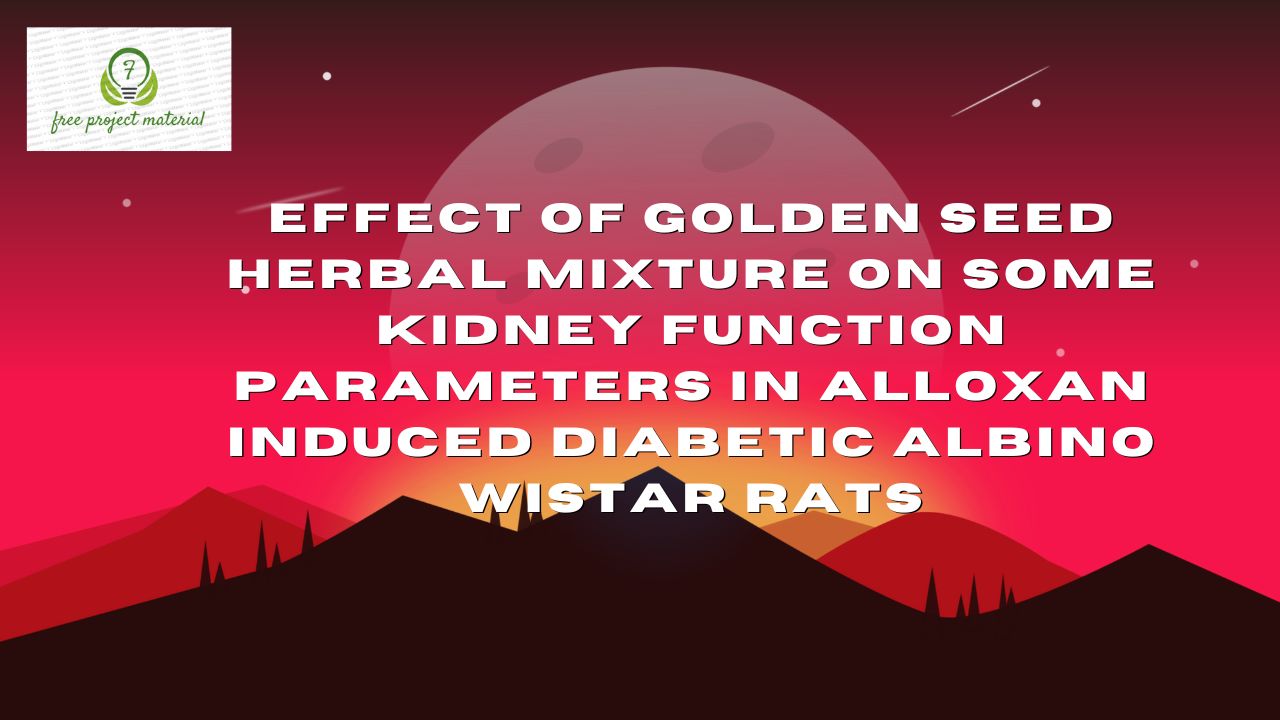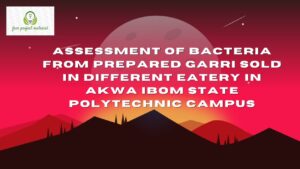ABSTRACT
This study was aimed at examining the effect of golden seed herbal mixture on some kidney function parameters in alloxan induced diabetic albino wistar rats. Twenty-five (25) male albino wistar rats weighing between 74g – 352g were randomly assigned five groups of five rats each. Group 1 served as the control and was sustained commercial rat chow and distilled water, group 2 served as the negative control and was administered with 150mg/kg body weight of alloxan groups 3, 4 and 5 were given same treated as group 2, thereafter they were administered with 0.5ml/kg, 1ml/kg and 2ml/kg body weight respectively. The result of the study revealed a non-significant decrease (P>0.05) in the serum level of creatinine in group 2 when compared to group 1. However, group 3 significantly increased (P<0.05) while groups 4 and 5 non-significantly increase when compared to group 2. Group 3 was also significantly higher than groups 4 and 5. The urea analysis revealed a significant decrease (P<0.05) in group 2 when compared to group 1. However, group 3 significantly increased when compared to group 2 while groups 4 and 5 non-significantly increase (P>0.05). Also, urea was significantly higher in group 3 when compared to groups 1, 4 and 5. The analysis further revealed a significant increase (P<0.05) in uric acid level of group 2 when compared to groups 1, while group 3 non-significant increase, group 4 had no change and group 5 significantly decrease when compared to group 2. This study further showed that group 5 was significantly lower than group 2, 3 and 4. This indicates that golden seed herbal might not be a better option for the treatment of kidney disease and diabetes in general, since this derangement were initiated by diabetes inducement. Thus, it is recommended that Further studies is recommended on the toxicity of golden seed herbal as well as it antinutritional contents in order to ascertain its safety for human consumption.
TABLE OF CONTENTS
Title Page – – – – – – – – – i
Certification – – – – – – – – – ii
Dedication – – – – – – – – – iii
Acknowledgements – – – – – – – v
Abstract – – – – – – – – – vi
Table of Contents – – – – – – – – vii
List of Tables – – – – – – – – x
List of Plates – – – – – – – – xi
List of Figures – – – – – – – – xii
CHAPTER ONE: INTRODUCTION
1.1 Background of the Study – – – – – – 1
1.2 Aims and Objective of the Study – – – – 4
1.2.1 Aims of the Study – – – – – – – 4
1.2.2 Objectives of the Study – – – – – – 4
1.3 Scope and Limitations of the Study – – – – 5
1.4 Significance of the Study – – – – – – 5
1.5 Abbreviation – – – – – – – 6
CHAPTER TWO: LITERATURE REVIEW
2.1 Diabetic Nephropathy or Diabetic Kidney Disease – – 7
2.2 The Natural Progression of Diabetic Kidney Disease – 8
2.3 Epidemiology of Diabetes – – – – – 10
2.4 Risk Factors of Diabetes – – – – – – 11
2.4.1 Race – – – – – – – – – 12
2.4.2 Aging – – – – – – – – 12
2.4.3 Smoking – – – – – – – – 13
2.4.4 Genetic Risk Factors – – – – – – 13
2.4.5 Arterial Hypertension – – – – – – 14
2.4.6 Hyperglycemia – – – – – – – 16
2.4.7 Lipid Disorders – – – – – – – 16
2.4.8 Increased Protein Intake – – – – – – 18
2.4.9 Chronic Inflammation – – – – – – 19
2.5 Golden Seed Herbal – – – – – – 20
2.5.1 Description of Golden Seed Herbal – – – – 20
2.5.2 Origin of Golden Seed Herbal – – – – – 23
2.5.3 Classification of Golden Mixture – – – – 24
2.5.4 Nutritional Value of Golden Seed Herbal – – – 26
2.5.5 Phytochemical Composition of Golden Seed Herbal – 28
2.5.6 Health Benefit of Golden Seed Herbal – – – – 29
2.6 Chemistry of Alloxan – – – – – – 31
2.7 Alloxan: Mechanism of Action – – – – 32
2.7.1 Beta Cell Selectivity of Alloxan – – – – 33
2.7.2 Glucokinase Inhibition – – – – – – 35
2.7.3 Beta Cell Toxicity and Diabetogenicity of Alloxan – 35
2.8 Biological Effects of Alloxan – – – – – 39
2.9 Kidney Function Parameters and their Biochemical
Significances – – – – – – – 41
2.9.1 Kidney Function Test – – – – – – 41
2.9.2 Creatinine – – – – – – – – 42
2.9.3 Urea – – – – – – – – 43
2.9.4 Uric Acid – – – – – – – 44
CHAPTER THREE: MATERIALS AND METHOD
3.1 Materials and Reagents – – – – – – 46
3.2 Methods – – – – – – – – 46
3.2.1 Sample Collection and Preparation of Samples – – 46
3.2.2 Preparation of Samples – – – – – – 47
3.2.3 Experimental Design and Grouping of Animals – – 47
3.2.4 Collection of Blood Sample – – – – – 49
3.3 Determination of Hormonal Profile Parameters – – 50
3.3.1 Determination of Testosterone – – – – – 50
3.3.2 Determination of Follicle-stimulating Hormone – – 51
3.3.3 Determination of Luteinizing Hormone – – – 51
3.4 Statistical Analysis – – – – – – – 52
CHAPTER FOUR: RESULT AND DISCUSSION
4.1 Physiological and Morphological changes on the animals – 53
4.2 Results – – – – – – – – 54
4.3 Discussion – – – – – – – – 56
CHAPTER FIVE: CONCLUSION AND RECOMMENDATIONS
5.1 Conclusion – – – – – – – – 64
5.2 Recommendations – – – – – – – 65
References
LIST OF TABLES
Table 4.1: Result of the effect of golden seed herbal mixture on the liver function of alloxan induced diabetic rats – – – – 54
LIST OF PLATES
Plate 1: Golden Seed Herbal Mixture – – – – – 23
LIST OF FIGURES
Figure 1: Structure of Alloxan – – – – – – 32
CHAPTER ONE: INTRODUCTION
1.1 Background of Study
Diabetes mellitus is a complex metabolic disorder in which the pancreas produces insufficient amount of insulin or in which individual system fail to respond appropriately to insulin. In people with diabetes, glucose levels build up in the blood and urine, causing excessive urination, thirst, hunger and problems with fat and protein metabolism (Kathleen, 1996). The disease is ranked seventh among the leading causes of death and third in terms of its complications and is a major health problem in developed and developing countries (Seidell, 2000). The number of diabetic patients is increasing globally because of diverse changes in diets in all cultures.
It has been predicted that the number of diabetic patients will double from 143 million in 1997 to about 300 million by 2025 largely because of dietary intake and other lifestyle factors (Seidell, 2001).
In the developing countries where majority of diabetic patients cannot afford effective but expensive drugs, the use of medicinal plants becomes used by various cultures to treat diabetes mellitus because of their hypoglycemic properties. Some of these medicinal plants Vernonia amygdalina (Olagunju et al., 2005), Unripe fruit of Carica papaya (Oloyede, 2005) and Aloe barbadensis (Adesokan et al., 2006).
Diabetic nephropathy (DN) is one of the important microvascular a complication of diabetes mellitus recent studies indicates that reactive oxygen species (ROS) play a key intermediate role in the pathophysiology of diabetic nephropathy (Miller et al., 2015). Hyper glycaemia, the main determinant of the initiation and progression of diabetic nephropathy, not only generates more reactive oxygen metabolites but also alternates anti-oxidative mechanism through monenzymatic glycosylation of antioxidant enzymes (Ramachandran, 2016). The mechanism by which hyperglyccaemia causes free radicals generation and thus causes oxidative stress is complex high glucose concentration directly increases hydrogen peroxide production by murine mesangical cells and lipid per-oxidation of glomeruli and glomerular mesangial cells (Edmund et al., 2006). Hyperglytaemia promotes glycosylation of circulating and cellular protein and may initiate a series of ant oxidative reactions that culminate in the information and accumulation of advances glycosylation and products (AGE) in tissue proteins (Banfi, 2006). The AGE has oxidizing potential and can promote tissue damage by free radicals. In addition, increased lipid peroxidation impairs membrane bound enzymes and receptors.
It products (lipid radicals and lipid peroxides) are harmful to the cells in the body and associated with atherosclerosis and damages to brain, kidney, liver and to other tissues (Mitchell and Kline, 2006). In addition diabetes bases and sugar phosphate binding sites (Pagana, 2002). The occurrence of these alterations can resists in mutagenic effects and DNA replication arrest and could be associated with for developing cancer in diabetes mellitus patients (Dharnidharka et al., 2002).
Medicinal plants have long been used for the treatment of DM. the disease was continued to manage entirely with such indigenous plants until the development of insulin injection therapy in 1921 (Guido et al., 2002). Several such plants have been identified as hypoglycemic either individually or in combination (Cholongitas et al., 2007).
Golden seed Herbal mixture is an effective herbal medicine for Staphylococcus aereus, noisy stomach, Quick Ejaculation, Vaginal discharge, candidiasis, internal heat, waist pain, typhoid, malaria fever, Ulcer. Direction Adult: 2 short morning and night. Children: from 5-12 year, 1 short morning and night size: 1 litre caution: not to be taken by pregnant women, Nursing mothers.
1.2 Aim and Objective of the Study
1.2.1 Aim of the Study
The basic aim of this research project is to determine the effect of Golden Seed Herbal Mixture Kidney function of albino wister rate induced with alloxan.
1.2.2 Objective of the study
- To determine the urea concentration of alloxan-induced Albino Wister rats treated with Golden Seed Herbal
- To determine the creatinine concentration of alloxan Wister rats treated with Golden Seed Herbal
- To investigate the morphological and physiological changes that occurred in the alloxan induced rats during the treatment with Golden Seed Herbal Mixture.
- To determine the uric acid concentration of alloxan Albino Wister rats treated with Golden Seed Herbal
- To make useful recommendation based on the result of the study.
1.3 Scope and Limitation of the Study
The scope of the study focuses on Golden Seed Herbal mixture on the kidney function parameter of make albino rats induced with alloxan.
However, this study is limited due to time and financial constraint.
1.4 Significance of the Study
- The result obtain from this research work will be useful to medical doctors, pharmacist, herbalist etc. as it will help in ascertaining the efficacy of Golden Seed Herbal in improving kidney function.
- This study will serve is a source of information to the public in order to guide their usage of the herbal mixture.
- This study will also serve as a reference materials to researchers and students in this field.
1.5 Definition of Terms
Kidney Function Test: Is a blood test that checks how well your kidneys are filtering your blood, called GFR. GFR stands for glomerular filtration rate. a urine test to check for albumin. Albumin is a protein that can pass into the urine when the kidneys are damaged
Diabetes: Diabetes is a chronic, metabolic disease characterized by elevated levels of blood glucose (or blood sugar), which leads over time to serious damage to the heart, blood vessels, eyes, kidneys and nerves.
Golden Seed herbal: Is an herbal mixture for treating malaria fever, typhoid, waist pain, ulcer, noisy stomach, worms, rheumatism, internal heat etc.
Diabetic nephropathy: Is the deterioration of kidney function.
Hyperglycemia: Hyperglycemia is a term for high blood sugar levels. It can indicate diabetes and cause severe health problems without careful blood sugar management.
1.6 Abbreviation
ROS – Reactive Oxygen Species
DN – Doctor of Naprapathic Medicine
ESRD – End Stage Renal Disease
VCAM – Vascular Cell Adhension Molecules
HS – High Sensitivity
TNFR-1 – Tumor Necrosis Factor – α Receptor-1
ICAM-1 – Intercellular Adhension Molecules-1
VEGF – Vascular Endothelial Growth Factor
GFR – Glomerulus Filtration Rate
GSH – Glutathione Supplement Health
HDL – High Density Lipoproteins
SOD – Superoxide Dismutase
BUN – Blood Urea Nitrogen
RFT – Request for Tender



